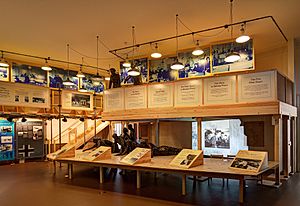Filter Room facts for kids

A Filter Room was a very important part of the RAF Fighter Command's radar system in Britain during Second World War. Think of it as the brain of the air defence network. The main Filter Room was at the top of the Dowding system. This system helped guide fighter planes to intercept enemy aircraft. The work done in these rooms was top secret.
Contents
How Filter Rooms Worked
When Britain set up its radar defence, Robert Watson-Watt and his team built many radar stations. These stations were called Chain Home (CH). Radar technology was new back then. It was hard to get a full picture from just one station.
So, the Filter Rooms were created to combine information from different radar stations. This helped them get accurate details about planes flying in or out. This process of putting all the information together was called "filtering." There were seven Filter Rooms in total. Each one was linked to a Fighter Command Group. A Group was in charge of several squadrons of planes and their airfields.
The people working in a Filter Room had to be very fast and accurate. They used clear English to avoid mistakes. There weren't many fighter planes, trained pilots, or much fuel. This meant every decision had to be quick and right.
The People Who Worked There
Several key roles made a Filter Room work:
Plotters
Plotters received radar information over the telephone. They put small counters on a large map table. These counters showed how high planes were, how many there were, and if they were friendly or enemy planes (this was called Identification Friend or Foe or IFF). Most plotters were young women from the Women's Auxiliary Air Force (WAAF). They worked eight-hour shifts, often in underground bunkers.
Filterers
Each radar station had a special colour. The plots (information points) were numbered one to five, showing when the information was received. Filterer Officers, or 'Filterers,' took this raw information. They corrected it and added an arrow to show the plane's direction and position. This information was displayed on a special metal plaque.
The Filterer's job was tricky. They had to decide when a few radar plots, even if a bit inaccurate, showed a real plane track. This track was then used by the operations room to send out fighter planes. Filterers had to choose quickly: should they act on their first guess, or wait for more information? Acting fast saved time but risked sending planes on a false alarm. Waiting for more info meant less chance of catching the enemy. Squadron Leader Mike Dean MBE explained that the Filterer's skill was key. They had to know how each radar worked and trust the crews. Their ability to quickly sort and understand the radar picture made the whole system successful.
Controllers
Controllers were senior officers. They used reports from other sections to figure out if a plane was friendly or hostile. This final information was then shared by WAAF tellers (who used telephones) with everyone who needed to know. This included Air Raid Warning Officers, the Royal Observer Corps, Anti-Aircraft Command artillery, Air Sea Rescue Centres, and Group and Sector Operations Rooms. These groups would then order fighter planes to intercept enemy aircraft. Controllers sat on a balcony above the filterers. Many Controllers were recruited from the London Stock Exchange. This was because they were used to making quick decisions under pressure.
Radar Improvements
Over time, radar equipment got better. Filter Rooms started getting reports from new types of radar, like Chain Home Low (CHL) and Chain Home Extra Low (CHEL). This made tracking planes even more accurate. In 1944, the Filter Rooms also helped warn about incoming V-1 flying bombs (often called "doodle bugs") and V-2 rockets.
See also

